Manchester’s skyline tells a story of ambition. Glass towers climb higher each year, cranes pivot across the horizon like instruments in a symphony of growth, and whole districts are reshaped right before our eyes.
The city has become a flagship for the Government’s housebuilding drive, with thousands of new homes planned and whole neighbourhoods transformed almost beyond recognition.
But amid the glittering rise of new developments, a persistent question remains: who really benefits? For residents facing rising rents, overstretched services, and the scramble for affordable housing, the answer is far from straightforward.
At the heart of this debate lies a little‑known but hugely important mechanism, the Section 106 agreement.
What is a section 106 agreement?
Introduced under the Town and Country Planning Act 1990, Section 106 agreements are legally binding deals between councils and developers. In return for planning permission, developers help offset the impact of their schemes, funding schools, parks, transport links or affordable housing.
Nationally, Section 106 has become a key tool for delivering affordable homes, accounting for over half of the 58,000 built in England last year.
Yet the picture in Manchester is complex. Contributions fluctuate wildly, money can sit unspent for years, and most affordable housing is actually delivered by other means. The city has enjoyed some successes, from refurbishing historic cottages in Moss Side to unlocking long‑derelict sites like the Ancoats Dispensary, but frustrations remain about whether communities are really seeing their fair share.
One of the starkest findings in Manchester City Council’s latest monitoring report is how unpredictable Section 106 income has become. In 2022/23, the city secured just under £1 million from developers. The following year, contributions surged to an unprecedented £5.7 million, before falling again to £1.65 million in 2024/25.
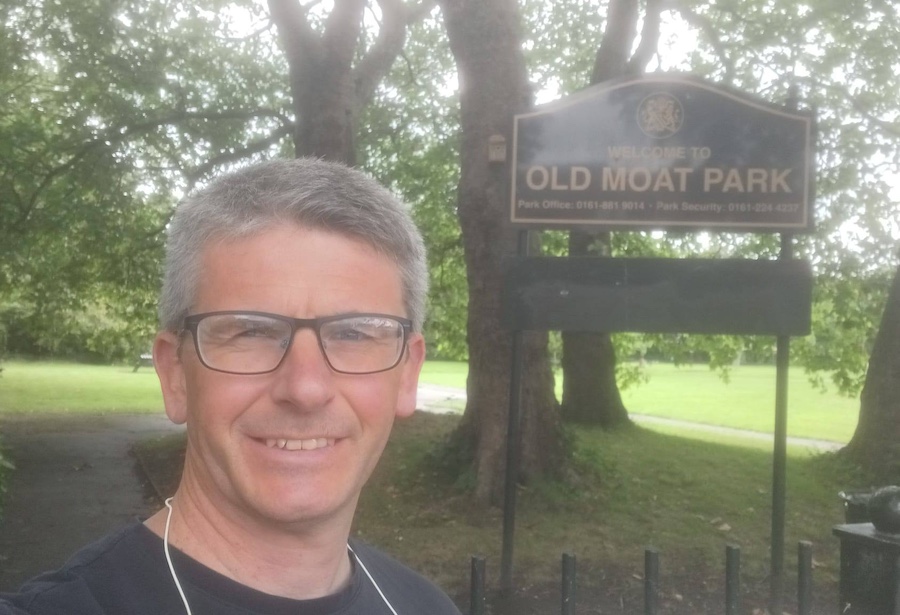 Cllr Gavin White spoke to I Love MCR about working with developers
Cllr Gavin White spoke to I Love MCR about working with developers
That volatility makes planning difficult. A big cheque one year may be followed by a trickle the next, undermining the ability to fund infrastructure or affordable housing at scale.
Compounding this stop‑start pattern is the gap between money received and money spent. Of the £5.7 million collected in 2023/24, only £1.77 million was actually deployed; the rest was tied up in legal, bureaucratic, or project‑timing delays.
“It’s important to remember Section 106 was never designed to deliver affordable housing at scale,” explains Councillor Gavin White, Manchester City Council’s Executive Member for Housing and Development. “Most of our social and affordable housing comes through grant funding, either from Homes England or through our own council‑led schemes.
“Section 106 makes up around 10% of the total, but where we can work with private developers and bring in a housing association partner, we can achieve better results.”
The numbers behind Manchester’s affordable housing gap
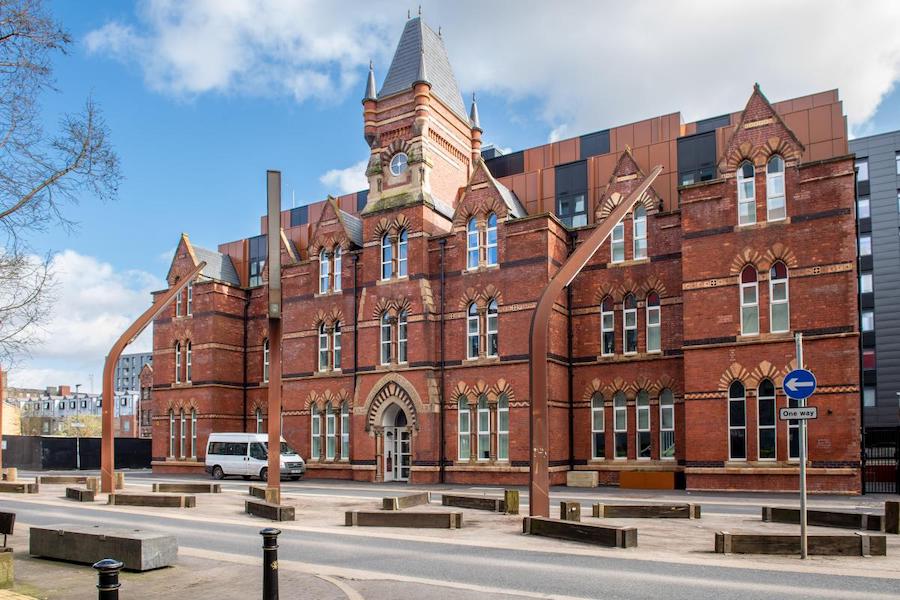 Ancoats Dispensary
Ancoats Dispensary
The numbers bear this out. In 2023/24, Manchester delivered 603 affordable homes. But 92% came via housing associations drawing on national grant programmes. Only a small fraction was secured through Section 106.
Still, those contributions matter in targeted ways. Money pooled into the Council’s Housing Affordability Fund (HAF) has supported projects such as:
Westwood Cottages, Moss Side: six historic almshouses refurbished for affordable rent.
Ancoats Dispensary: 39 new affordable apartments created in a landmark building.
390 Princess Road: a property converted into temporary accommodation for people moving on from homelessness services.
This City, Ancoats: £2m directed into delivering 38 homes at the Manchester Living Rent as part of a larger development due in 2025.
For Cllr White, these projects show the versatility of Section 106. “We’ve been able to use contributions from city-centre skyscrapers to bring heritage buildings back into use, like the Ancoats Dispensary,” he said. “It’s not just about numbers, it’s about making sure development benefits the wider community.”
Negotiating those benefits isn’t always straightforward. Developers often argue that too many obligations make schemes unviable, and Manchester has faced this “viability challenge” time and again.
“Sometimes negotiations are tough,” Cllr White acknowledged. “Developers are businesses and want to maximise profits. But increasingly, if they want to build in Manchester, they know they have to be part of the bigger picture, delivering not just homes, but schools, green spaces and the infrastructure that makes communities sustainable.”
To prevent under-delivery, the Council now includes “clawback” clauses in agreements, allowing it to reclaim extra funds if completed schemes prove more profitable than first forecast.
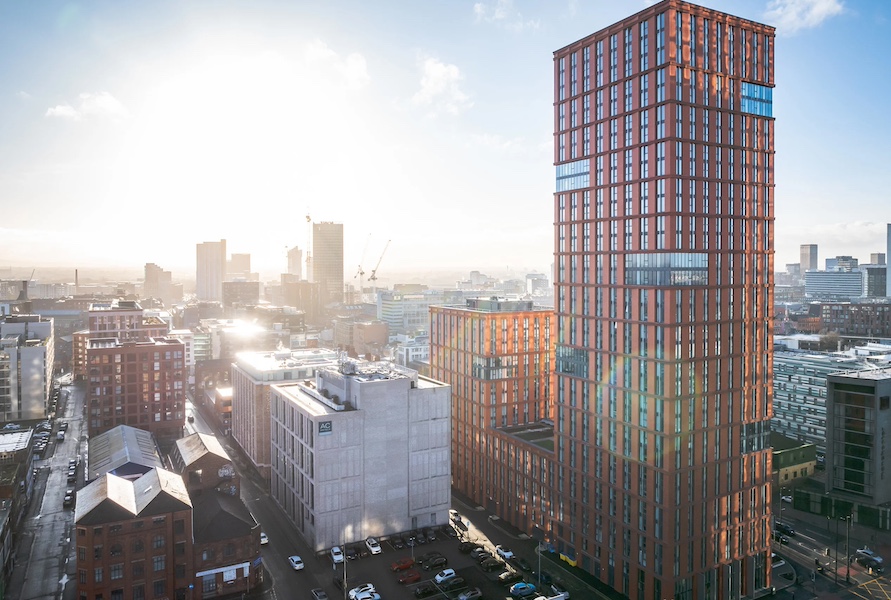 The Swan Street Developments
The Swan Street Developments
The system has shown promising signs. At Swan Street, a development of 373 apartments, reassessment after completion yielded an extra £700,529 for affordable housing. Not all schemes produce surpluses, but the principle signals Manchester’s determination not to let windfall profits escape community benefit.
Section 106 is ‘not all about housing’
Section 106 is not confined to housing. Across Manchester, it has channelled funds into sports facilities, environmental improvements, and community spaces. Recent examples include:
– Debdale Park, Gorton and Abbey Hey: £789,000 secured to create new sports pitches, including drainage and maintenance to ensure long‑term use.
– Cheetham Hill: funding used to replace dead Austrian Pines along Bury New Road and support a community garden.
–Manchester College’s Arden Centre: a £640,000 package delivering a new bus shelter, pedestrian crossing, and replacement sports pitch.
For Cllr White, this breadth is crucial. “If you’re going to sell homes, people want good public transport, schools, and parks nearby. Working with us to deliver those things isn’t just good for residents, it makes developments more attractive for the market too.”
How to meet Manchester’s rapidly growing population
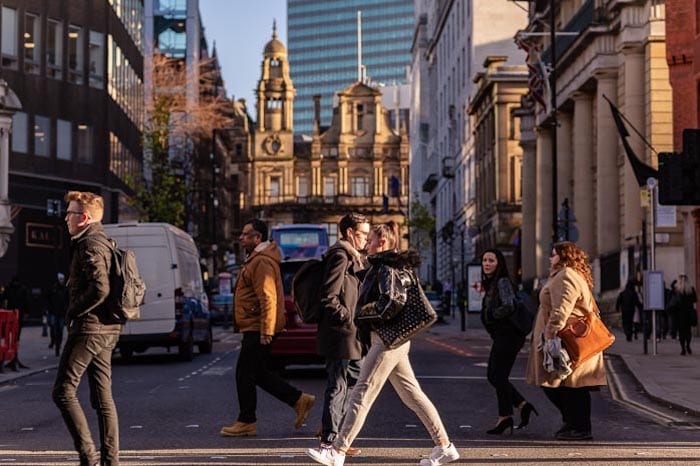 Manchester’s population is rapidly rising
Manchester’s population is rapidly rising
Manchester’s rapid population growth has brought unique challenges. Thirty years ago, barely 500 people lived within the inner ring road. Today, tens of thousands call the city centre home.
That reversal means the Council is often building communities “backwards”: retrofitting schools, surgeries, and parks into areas that were once largely commercial.
New schools at Deansgate Square and New Islington, the creation of Mayfield Park, and riverside green spaces at Victoria North all reflect attempts to keep pace.
“Where we can, we try to build the park first, then the homes,” said Cllr White. “At Mayfield we managed that. At Victoria North, we’re trying to deliver both in parallel, cleaning up the River Irk, reclaiming brownfield land, and building homes alongside new public spaces.”
What is the ‘Manchester Living Rent’?
One of Manchester’s most distinctive innovations is the “Manchester Living Rent.” Designed as a middle ground between unaffordable private rents and traditional social housing, it caps rent at the Local Housing Allowance, ensuring people on benefits can afford it.
“Our local plan sets out that 30% of all new housing should be affordable,” White explains. “Of that, 70% will be social rent, 10% at the Manchester Living Rent, and 20% for low‑cost home ownership.
“At the moment, it’s voluntary, but we are seeing developers sign up. It’s about making sure affordability is real, not just a label.
“We know there’s huge demand for housing in Manchester,” he said. “People want to live here. Our job is to make sure that growth works for everyone, and that means holding developers to account, but also working with them to deliver sustainable communities.”
You can find out more about Manchester Living Rent by clicking here
The Planning and Infrastructure Bill 2025
National reforms are also looming. The Government’s proposed Planning and Infrastructure Bill 2025 would move viability testing to the Local Plan stage rather than at individual applications. In theory, this reduces wrangling.
In practice, it may limit councils’ flexibility to demand more if conditions change.
Another shift is the new legal requirement for a 10% biodiversity net gain on all development sites. While positive for the environment, it risks diverting contributions away from affordable housing or community facilities. Councils like Manchester will face tough trade‑offs.
Manchester’s Housing Strategy 2022–2032
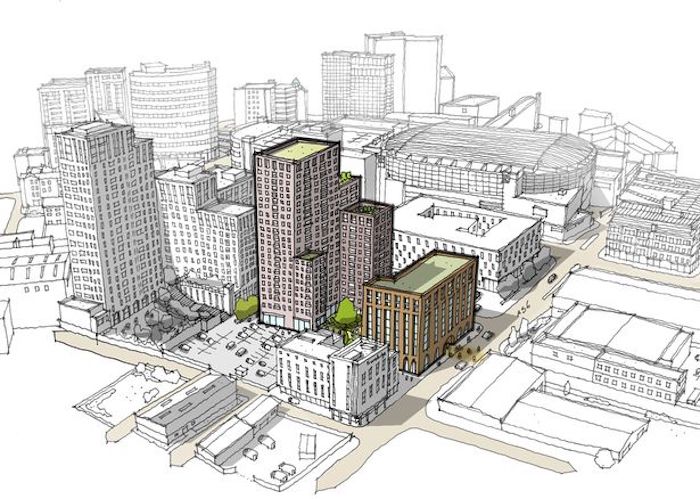 Boddingtons Brewery redevelopment
Boddingtons Brewery redevelopment
Manchester’s Housing Strategy 2022–2032 sets an ambitious target of 10,000 new affordable homes by 2032. Progress is visible: 40% of the affordable homes built last year were for social rent, the highest proportion in over a decade. Flagship schemes like Laystall Street (100% affordable), Viadux 2 (29% affordable), and the Boddington’s Clarion site (60% affordable) point to a city determined to change its trajectory.
Yet the sums involved in Section 106 remain modest compared to the scale of need. A record £5.7 million in one year is dwarfed by the billions required for housing, infrastructure, and services. For White, the key is partnership: national grants, council‑led schemes, housing associations, and yes, developer contributions, all pulling together.
You can read Manchester’s Housing Strategy by clicking here
What did Salboy say about Viadiux 2?
We reached out to several developers active across Manchester’s booming property market to hear their perspectives on Section 106 obligations, affordable housing targets, and the wider debate about who benefits from the city’s rapid growth.
Only Salboy, one of Manchester’s most prominent developers, chose to comment.
Speaking about their upcoming Viadux 2 scheme off Deansgate, a major mixed-use development set to reshape part of the city centre skyline, a spokesperson for Salboy said: “Viadux 2, the recently approved second phase of our flagship scheme in Deansgate, will be home to Manchester’s first city-centre, purpose-built affordable housing block for decades. Viadux 2 will comprise two towers; one of which will contain 133 affordable homes across 23 floors.”
The company stressed that it complies fully with both Manchester City Council and Salford City Council’s affordable housing and Section 106 requirements: “All of our new developments meet affordable housing and Section 106 requirements, and we work closely with both councils to ensure that the schemes we bring forward meet their affordable housing policies too. The proportion of units reserved for affordable housing varies from scheme to scheme.”
Salboy also emphasised its commitment to sustainability and energy efficiency, arguing that responsible construction can go hand in hand with growth: “We take all practical, common-sense measures to ensure that our schemes meet sustainability and low-carbon objectives, both during construction and throughout their lifetime. For instance, many of our developments are built using electric JCB handlers, then use air source heat pumps to efficiently warm upper apartments and amenity areas, as well as MVHR systems for heat recovery and efficient building fabric with low air permeability.”
They added that features such as smart lighting controls, EV charging points, and a preference for renovation over demolition are now standard practice in their projects: “We aim to preserve Manchester’s heritage wherever possible, renovating rather than rebuilding when viable – while ensuring new developments contribute positively to the city’s sustainability goals.”
Salboy’s response underscores the developers’ case: that they are not only delivering on legal obligations but also investing in sustainability and affordable homes within the constraints of commercial viability.
You can find out more about Salboy’s Viadux 2 scheme by clicking here
 Viadux 2a
Viadux 2a
For all the planning policies and legal frameworks, the true impact of development is felt most keenly by those living closest to it. In Collyhurst, one of the areas undergoing major regeneration as part of the Northern Gateway masterplan, residents are watching the city’s transformation with a mix of hope and frustration.
Anne Worthington, who has lived in Collyhurst for years, said she sees clearly who gains the most from Manchester’s current wave of building.
 Anne Worthington
Anne Worthington
“Developers mostly,” she said. “Then incoming professionals who can afford the properties. Some local residents will be pleased with regeneration, but some of the homes and areas have been neglected by their landlords for years, and it often feels like we’re not really the ones benefiting.”
Anne points to a long list of promised infrastructure projects in her neighbourhood that have yet to materialise. “We’ve been told there will be new doctors’ surgeries, a transport hub and a metro stop, but when we asked when these would be built, we were told ‘when the footfall warrants it’. In other words, we’re not worthy.”
She fears that the nearby Irk Valley development, with its riverside paths and landscaped public realm, is more about beautifying the area for new private buyers than serving existing residents. “It looks amazing, but that’s not for us, it’s for the £300,000 and £400,000 homes going up on Danzic Street and Redbank,” she said.
“In Collyhurst Village, a new park is promised on the site of the first block of mainly social homes once they’re demolished. But we can’t get an answer on whether there’ll be a replacement playground. Collyhurst Big Local spent £150,000 on the current one, will that just be trashed?”
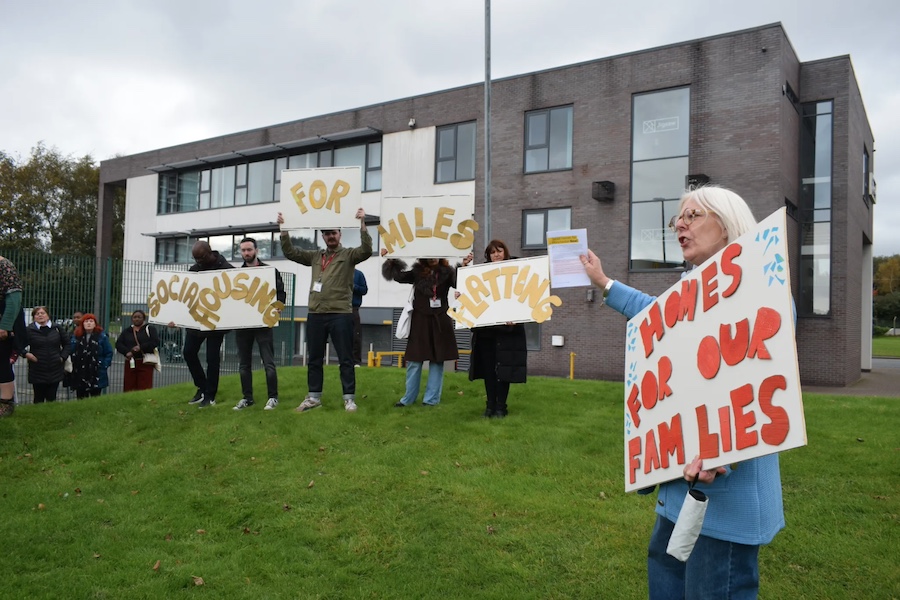 Anne is out on the campaign trail
Anne is out on the campaign trail
Her frustration is compounded by what she sees as a mismatch between the city’s housing pipeline and real local need. “Our community is crying out for more family homes,” she said. “Lack of affordable or social housing leads to multigenerational living and overcrowding. I know a family who were offered a suitable social home, but in Wythenshawe. The mother couldn’t take it because she’d lose her support network. So she’s still in private rent, with the constant worry of eviction hanging over her.”
When asked what a fair deal from development would look like, Anne doesn’t hesitate. “At least 30% social homes,” she said firmly. “Not 30% of 70%, which only works out at 21%. That’s not enough.”
She also believes residents should have a say much earlier in the planning process. “Hopefully, before we’re asked things like, ‘What do you think about wheely bin storage?’” she laughs, a wry acknowledgement of the disconnect many communities feel between consultation and decision-making.
Social Homes for Manchester
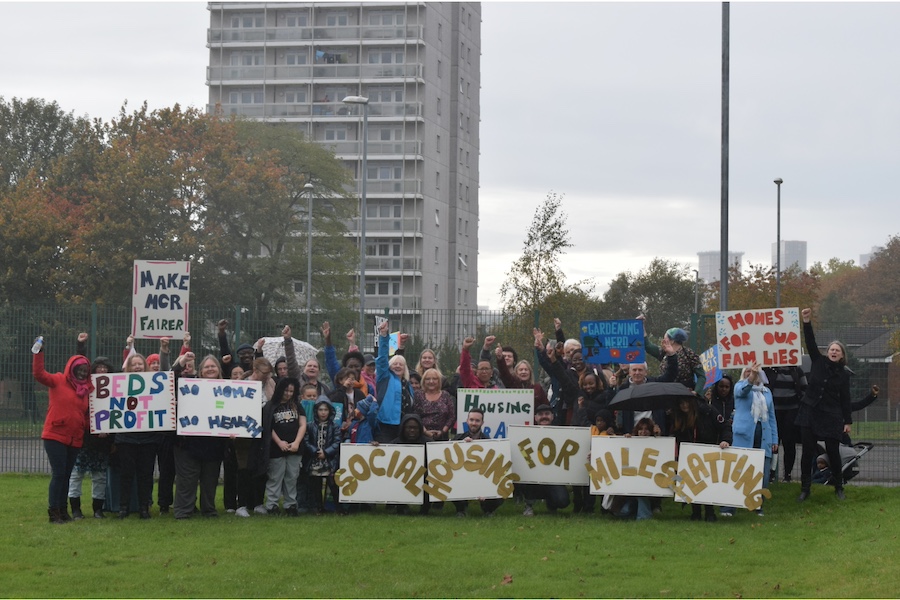 Social Homes for Manchester
Social Homes for Manchester
According to Social Homes for Manchester, the city’s approach to affordable housing is improving but still falls short of meeting the scale of the crisis.
The group welcomes the draft Local Plan’s proposal to raise the overall affordable housing target to 30%, with 70% of that for social rent. However, they note this equates to only about 21% social rent overall, well below what’s needed. Citing research by Dr Isis Barei-Guyot (University of Manchester) and Associate Professor Stuart Hodkinson (University of Leeds), they point out that Manchester’s own housing needs assessment identified a 30% affordable housing requirement as far back as 2007.
The campaign argues the Council should go further, requiring that 30% of all new developments of ten homes or more be for social rent. They note other major cities already set 30–60% affordable or social rent quotas in some areas and suggest Manchester could adopt a zonal approach, with higher targets in stronger markets and more flexibility in lower-value areas.
Exploring the ‘viability loophole’ for developers
The group also draws attention to a wider national issue affecting local authorities: the “viability loophole” that allows developers to negotiate down their Section 106 contributions by claiming that higher obligations would make projects financially unviable.
This, they argue, has systematically weakened councils’ ability to secure fair returns for affordable housing and social infrastructure. While they acknowledge that most social housing will continue to rely on central government grant funding, they stress that this should not absolve private developers, many of whom make substantial profits from Manchester’s ongoing regeneration, from contributing their fair share.
Working alongside housing charity Shelter, Social Homes for Manchester is calling for reforms to national planning policy to close the viability loophole and introduce consistent, mandatory requirements for developer contributions. Such measures, they argue, would prevent developers from “city shopping” to find areas with the weakest obligations and would ensure a level playing field across the country. In their view, this is essential if cities like Manchester are to secure a genuinely fair return through Section 106 agreements and meet the scale of demand for truly affordable, socially rented homes.
You can find out more about Social Homes for Manchester’s work by clicking here
Making Manchester developments for all
Manchester is booming, and the cranes and buildings will keep rising. But the true test will not be the number of towers or the pace of construction. It will be whether residents can find homes they can afford, parks where their children can play, and services that keep pace with demand.
Section 106 agreements are just one piece of that puzzle: imperfect, volatile, sometimes frustrating, but nonetheless a vital lever. In the end, Manchester’s challenge is not just to build faster or taller, but to ensure that prosperity is shared across the communities that call the city home.
